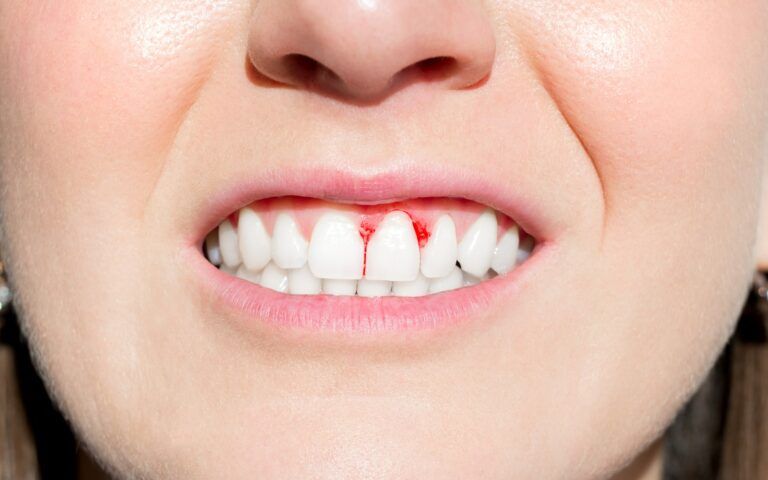Finding a little blood on your toothbrush every so often isn’t unusual. When it starts to happen, every time you brush, you may have something to cause worry. While bleeding can be the result of overly aggressive brushing or flossing, it should be infrequent. Once the frequency starts to pick up, it’s time to speak to your dentist. Bleeding gums are a frequently encountered symptom of gingivitis and periodontitis. While you may need to change your toothbrush, it pays to check with a professional.
Periodontal Disease, Gingivitis, and Periodontitis
Periodontal disease is a catch-all term for the two types of gum disease. Gingivitis and periodontitis are caused by one of the hundreds of species of bacteria that live in our mouths. Many of these bacteria are helpful; some are merely harmless. One, in particular, poses a severe threat to our oral health. That one is streptococcus mutans, and it is responsible for tooth decay and periodontal disease. A significant factor in these conditions is the acid it secretes after eating sugar.
The earliest stage of gum disease is known as gingivitis. With this condition, our gums are irritated and sensitive, both the result of bacteria. Mutans haven’t gotten into the gums at this point. Instead, it lives on the outside of the gums, causing inflammation. Once the bacteria manages to establish itself in the gums themselves, trouble begins. At this stage, the condition changes to periodontitis, and your oral health is in danger. Without the help of your dentist, there’s no practical way to reverse periodontitis.
Common symptoms of periodontitis include:
- Pinking of your toothbrush from bleeding
- Gums that have become swollen and tender
- Persistent bad breath even after brushing
- Gingival pockets forming between your gums and teeth
Any of these symptoms are a cause for worry. When they start to appear in multiples, swift action is needed. Reach out to your dentist to get the help that you need.
Discover The Most Effective Treatments for Gingivitis
Speaking to your dentist is the first important step to getting help with periodontal disease. They’ll discuss your circumstances and present you with appropriate options. One of two solutions is likely to be presented:
- Scaling and root planing: This is a two-step process that has been proven to be effective at eliminating periodontal disease in patients. Another term for this treatment is ‘deep cleaning.’ Using a tool called a scaler, the dentist will remove biofilm from beneath your gum line. The roots will then be planed or smoothed to prevent bacterial reattachment.
- Laser treatment: Recently, dental technology has seen the inclusion of laser treatment for periodontitis. Specially tuned lasers are capable of eliminating infected tissue without harming healthy tissue nearby. The process is painless and proving to be incredibly effective.
The most important tool you have in preventing gum disease is maintaining a good oral hygiene routine. This process includes brushing at least twice daily, flossing, and giving a rinse with mouthwash. You may also want to include fluoride supplements to help strengthen your teeth.
Finding a little blood on your toothbrush every so often isn’t unusual. When it starts to happen, every time you brush, you may have something to cause worry. While bleeding can be the result of overly aggressive brushing or flossing, it should be infrequent. Once the frequency starts to pick up, it’s time to speak to your dentist. Bleeding gums are a frequently encountered symptom of gingivitis and periodontitis. While you may need to change your toothbrush, it pays to check with a professional.
Periodontal Disease, Gingivitis, and Periodontitis
Periodontal disease is a catch-all term for the two types of gum disease. Gingivitis and periodontitis are caused by one of the hundreds of species of bacteria that live in our mouths. Many of these bacteria are helpful; some are merely harmless. One, in particular, poses a severe threat to our oral health. That one is streptococcus mutans, and it is responsible for tooth decay and periodontal disease. A significant factor in these conditions is the acid it secretes after eating sugar.
The earliest stage of gum disease is known as gingivitis. With this condition, our gums are irritated and sensitive, both the result of bacteria. Mutans haven’t gotten into the gums at this point. Instead, it lives on the outside of the gums, causing inflammation. Once the bacteria manages to establish itself in the gums themselves, trouble begins. At this stage, the condition changes to periodontitis, and your oral health is in danger. Without the help of your dentist, there’s no practical way to reverse periodontitis.
Common symptoms of periodontitis include:
- Pinking of your toothbrush from bleeding
- Gums that have become swollen and tender
- Persistent bad breath even after brushing
- Gingival pockets forming between your gums and teeth
Any of these symptoms are a cause for worry. When they start to appear in multiples, swift action is needed. Reach out to your dentist to get the help that you need.
Discover The Most Effective Treatments for Gingivitis
Speaking to your dentist is the first important step to getting help with periodontal disease. They’ll discuss your circumstances and present you with appropriate options. One of two solutions is likely to be presented:
- Scaling and root planing: This is a two-step process that has been proven to be effective at eliminating periodontal disease in patients. Another term for this treatment is ‘deep cleaning.’ Using a tool called a scaler, the dentist will remove biofilm from beneath your gum line. The roots will then be planed or smoothed to prevent bacterial reattachment.
- Laser treatment: Recently, dental technology has seen the inclusion of laser treatment for periodontitis. Specially tuned lasers are capable of eliminating infected tissue without harming healthy tissue nearby. The process is painless and proving to be incredibly effective.
The most important tool you have in preventing gum disease is maintaining a good oral hygiene routine. This process includes brushing at least twice daily, flossing, and giving a rinse with mouthwash. You may also want to include fluoride supplements to help strengthen your teeth.


